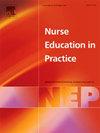护理本科学生的深度学习方法及其与学习成果的关系:一项潜在分析
IF 3.3
3区 医学
Q1 NURSING
引用次数: 0
摘要
深度学习方法在护理教育中发挥着关键作用,使学生具备应对复杂临床挑战所需的批判性思维技能和知识。然而,受个人特点、学术环境和教学方法的影响,护理专业学生表现出不同的深度学习方法。目的探讨护理本科学生深度学习的潜在特征,分析影响这些特征的因素及其与学习效果的关系。设计一项描述性横断面调查。方法于2024年5月至7月对全国两所医科大学的891名本科护生进行研究。使用深度学习量表和学习成果量表收集数据。采用潜在特征分析来识别深度学习特征。采用单因素方差分析和多项logistic回归分析探讨不同剖面的影响因素。采用Bolck-Croon-Hagenaars (BCH)方法研究不同背景学生学习成果的差异。结果发现深度学习的4种潜在特征:“综合性深度学习者”(27.0% %)、“能力导向型学习者”(25.4% %)、“态度驱动型学习者”(21.7% %)和“表面应对型学习者”(25.8% %)。性别、年级、护理专业偏好和参与翻转课堂是影响档案隶属度的显著因素(p <; 0.05)。“综合深度学习者”的学习成果得分最高,而“表面应对学习者”的学习成果得分最低。结论护理本科学生在深度学习方法上存在显著的异质性。“综合深度学习者”取得了最高的学习成果。护理教育应根据不同深度学习的特点,采取针对性的干预措施,提高学生的学习效果和综合能力。本文章由计算机程序翻译,如有差异,请以英文原文为准。
Deep learning approach in undergraduate nursing students and their relationship with learning outcomes: A latent profile analysis
Background
Deep learning approach plays a pivotal role in nursing education, equipping students with the critical thinking skills and knowledge necessary to address complex clinical challenges. However, nursing students exhibit diverse approaches to deep learning, affected by individual characteristics, academic environments and teaching methods.
Objective
This study aims to identify latent profiles of deep learning approach among undergraduate nursing students and analyze the factors influencing these profiles and their association with learning outcomes.
Design
A descriptive cross-sectional survey.
Methods
A total of 891 undergraduate nursing students from two medical universities in China participated in this study between May and July 2024. Data were collected using the Deep Learning Scale and the Learning Outcomes Scale. Latent profile analysis was employed to identify deep learning profiles. One-way analysis of variance and multinomial logistic regression were used to explore influencing factors of different profiles. The Bolck-Croon-Hagenaars (BCH) method was applied to examine differences in learning outcomes across profiles.
Results
Four latent profiles of deep learning were identified: "Comprehensive Deep Learners" (27.0 %), "Ability-Oriented Learners" (25.4 %), "Attitude-Driven Learners" (21.7 %) and "Surface Coping Learners" (25.8 %). Gender, grade, preference for the nursing major and participation in flipped classrooms were significant factors influencing profile membership (p < 0.05). "Comprehensive Deep Learners" had the highest learning outcome scores, while "Surface Coping Learners" scored the lowest.
Conclusions
Significant heterogeneity exists in deep learning approach among undergraduate nursing students. "Comprehensive Deep Learners" achieved the highest learning outcomes. Nursing education should adopt tailored interventions based on the characteristics of different deep learning profiles to improve students’ learning outcomes and comprehensive competencies.
求助全文
通过发布文献求助,成功后即可免费获取论文全文。
去求助
来源期刊

Nurse Education in Practice
NURSING-
CiteScore
5.40
自引率
9.40%
发文量
180
审稿时长
51 days
期刊介绍:
Nurse Education in Practice enables lecturers and practitioners to both share and disseminate evidence that demonstrates the actual practice of education as it is experienced in the realities of their respective work environments. It is supportive of new authors and will be at the forefront in publishing individual and collaborative papers that demonstrate the link between education and practice.
 求助内容:
求助内容: 应助结果提醒方式:
应助结果提醒方式:


